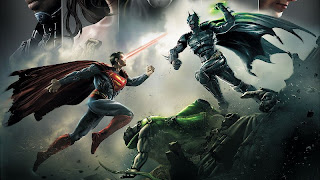First Impressions - Gears of War: Judgment brings new ideas to the series but stubborn fans may not approve
 |
| (wikipedia.org) |
“Gears of War: Judgment” marks the first time in the series
that someone other than Marcus Fenix is in the spotlight, though the new
protagonist is already well-known to fans. Damon Baird, mechanical whiz and all
around smart ass, takes the lead role in “Judgment,” along with everyone’s
favorite Thrashball player, Augustus Cole. Two new faces join Baird and Cole to
round out Kilo squad – Sofia Hendrik, an Onyx guard cadet, and Garron Paduk, a
former UIR soldier.
“Judgment” is also unique in that it tells a story closer to
the beginning of humanity’s war with the Locust on the planet Sera. Told
through a series of flashbacks, where different characters take the lead role
while they relate different parts of the story, it’s very interesting to see
Sera and the COG before the Locust horde ruined much of their civilization. As
the game begins, we see that Kilo squad is being led, in handcuffs, into a
military tribunal where they are questioned about some sort of heinous crime
that they are accused of committing. As the game roles on, you’re given bits
and pieces of information which keys you in on their actions but given the
circumstances of their trial – it’s being held in a crumbling hall as the city
burns around them – Baird and crew must have done something pretty serious.
I really liked the setting and the change of characters from
the established “Gears” storyline. Setting the story earlier in the timeline of
the war with the Locust and introducing new elements and characters to the
war’s history gives you a perspective of just how far humanity falls during the
conflict. Sure there’s always the problem of retcon when adding new elements to
an earlier time in an established story, but everything that “Judgment” adds
feels so natural, you hardly notice.
The theme of the game so far has been “change from the
original,” as we’ve already seen from the storyline and the characters
populating it. Not to be left out, the gameplay of “Judgment” sports some
serious departures from the original trilogy of games. Each section of the
story told equals a mission. Each mission now features a three-star rating
system, where a better performance (kills, gibs, earning ribbons, etc) earns
stars quicker and a post-mission stat screen meters out exactly how your
performance affected your star rating to give you an idea of how to improve. Other
changes to the gameplay include reducing the amount of guns you can carry to
two (switched with the Y button) and quicker gameplay.
Overall, it seems that “Judgment” has a more arcade approach
to combat and gameplay – meaning there is a bigger emphasis on scoring points
than just surviving battles and reaching your next objective. It’s a huge
departure from the story-driven narrative of the original trilogy but I really
enjoyed the way that you can play for 10-20 minutes and still get a feeling of
accomplishment. Purist fans may not see it that way, though, and feel that it’s
too much of a difference from the series they know and love.
There is another new element to the new mission make-up of
“Judgment.” Near the start of each mission, you’re given the option to play the
“declassified” version of said mission. Selecting this option will impart some
new stipulation on the mission that will usually up the difficulty but also
allow you to earn stars much more quickly. These declassified mission elements
can be as simple as restricting your arsenal to certain weapons but some can
completely change your approach to a mission. Declassifying a mission isn’t
required, though you’ll have a tough time getting three stars without doing it.
So far, it seems that earning stars really only goes towards
unlocking a post-campaign chapter called “Aftermath.” Though you do need 40
stars to unlock it and with each mission only offering a max of three stars,
you’ll need all you can get to unlock the epilogue chapter. Also, as in
previous titles, your story campaign progress translates to your overall
persistent XP pool, which lets you unlock new weapon and character skins and
other customization options.
Developer Epic Games was joined by developer People Can Fly
for “Judgment” and the influence of the new studio was seen all over this
title. Having played People Can Fly’s previous offering, “Bulletstorm,” I could
see the similarities almost immediately with the faster action and the arcade
presentation. Though, hardcore fans of the series may not be too comfortable
with the changes to their beloved franchise, I found “Judgment” to be a breath
of fresh air to a series that was getting a bit stagnant.
 RSS Feeds
RSS Feeds









